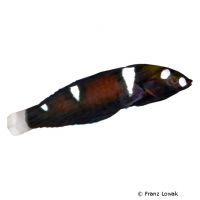Queen Coris (Coris formosa)
| Queen Coris Coris formosa | |
|---|---|
| Name | Queen Coris |
| Name Lat. | Coris formosa |
| Synonym | Coris frerei |
| Family | Wrasses |
| Family lat. | Labridae |
| Order | Wrasses & Relatives |
| Order lat. | Labriformes |
| Origin | Indian Ocean, Red Sea |
| Habitat | Lagoons, sandy areas |
| Diet | Carnivore |
| pH | 8,1-8,4 |
| Hardness | 8-10 °KH |
| Behavior | Semi-aggressive |
| Keeping | Individual, group |
| Reef Compatible | With caution |
| Care Level | Moderate |
| Life Span | N/A |
| Protection | No |
| Metric Units | |
| Size | 50 cm |
| Temperature | 24-27 °C |
| Salinity | 33-36 ‰ |
| Aquarium | ~ 1.100 l |
| US Units | |
| Size | 20" |
| Temperature | 75-81 °F |
| Salinity | 1.020-1.025 sg |
| Aquarium | ~ 290 gal |
Distribution and habitat
The distribution area of Coris formosa is the western Indian Ocean, from the southern Red Sea over the coasts of East Africa to Sri Lanka. They live mostly solitary in lagoons and on reefs over seagrass, rocks and corals up to 50 m depth.
Maintenance
They need a well structured aquarium with rock or stone structures with living stones, which offer enough hiding and covering possibilities as well as sufficient swimming space and a bottom substrate consisting of a layer of sand at least 20 cm deep (no coral rubble!). Only lime-rich, heavy metal-free sands, gravels, stones or sea sand may be used.
Filters, skimmers and heaters are necessary to ensure water quality, as well as pumps to simulate tides, swell and bottom currents. Lighting must be appropriate for the species' day-night rhythm
| Salinity: 33-36 ‰ | pH value: 8.1-8.4 |
| Carbonate hardness: 8-10 °KH | Nitrate content: 2-8 mg/l |
| phosphate content: 0.01-0.1 mg/l | nitrite content: 0.0-0.05 mg/l |
For salinity, an average value should be aimed for, which may only vary slightly by +/- 0.5 ‰. Ammonia and ammonium must not be measurable. Special attention must be paid to constantly good water quality.
Diet
They feed on small crustaceans and mollusks. The food change does not always succeed without problems. The food supply should consist of a combination of chopped shrimp, mussel and crab meat, plus live and frozen food such as mysis, krill, artemia and shrimp or a frozen food mix enriched with vitamins. High-quality flake and granulated food is also often accepted after an acclimation period
It is recommended to feed small portions several times a day, this reduces intra-species aggression and protects lower animals in the aquarium. Regular and varied feeding promotes health and increases resistance.
Behaviour and compatibility
The juveniles, mostly females, are peaceful among themselves. With sexual maturity the intra-species aggression increases. Group keeping is only possible in a much larger, richly structured tank. They can be well socialized with other not too small fish.
Sex dimorphism
They are protogynous hermaphrodites, meaning that most males develop from functional females when needed. Adult males have a light blue body with longitudinal blue stripes and several green stripes on the head. Females are dark blue to green in color with black spots and diagonal light blue stripes on the head
Reproduction and breeding
There are no known reports of successful breeding in the aquarium
Important
Juveniles are clearly different from adults in markings and coloration
As reef dwellers, they should be kept together with corals and not in a fish-only aquarium. Only tubeworms, snails, crabs etc. should be kept with caution
Overnight and when threatened they bury themselves in the sandy substrate
If different species are kept together, make sure that the fish match each other in terms of water quality and temperature requirements, as well as their social behavior, and that the setup meets the needs of all species kept together. Newly introduced fish must be acclimated slowly to the water in the aquarium
Further literature can be found in your pet store.
References
Text: Werner Winter; Image: Franz Lowak
Source: BAENSCH & DEBELIUS (2006): Meerwasser Atlas Bd. 1, Mergus Verlag; ENGELMANN (2005): Zootierhaltung - Tiere in menschlicher Obhut: Fische, Verlag Harri Deutsch
- Gemäß § 21 Abs. 5 Tierschutzgesetz idgF
